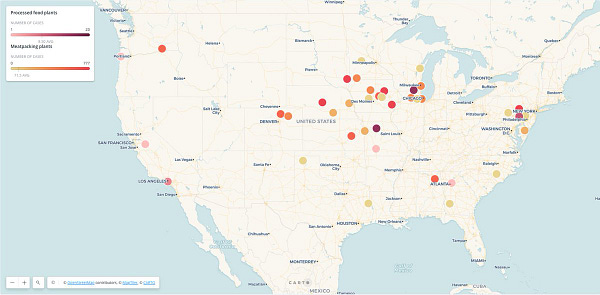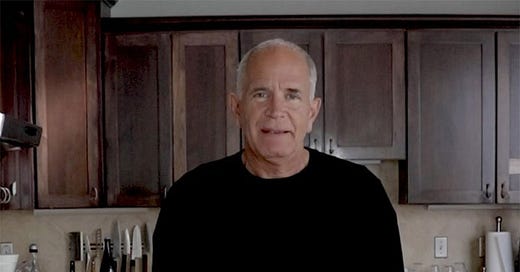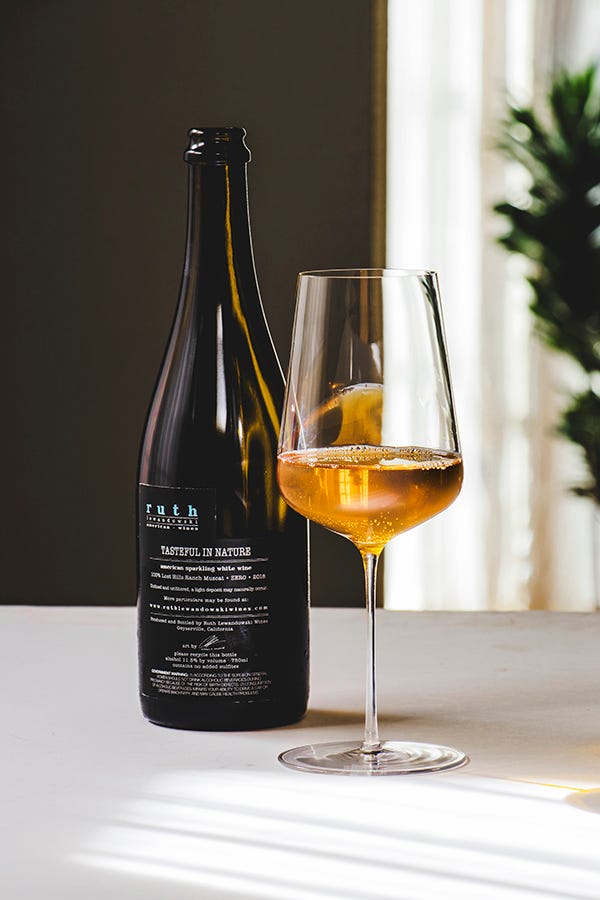For the longest time we subscribed to the “whack a pomegranate with a spoon" method, which loosened the seeds from the membrane inside, making it easier to separate them once you cut it open. Then we transitioned to the “opening a pomegranate while submerged in a bowl of water” method, preventing juice from spraying everywhere while you extracted the seeds. And then there’s the combination of both these methods from Food 52: A Pomegranate Seeding Technique You Have to Try to Believe. Now we’ve finally arrived at the ultimate method of simply cutting the pomegranate open in sections with a knife. A bit anticlimactic after all that and of course this genius technique has been used throughout the Middle East since forever.
By the way, I'm Bruce Cole, Publisher of Edible San Francisco. If we haven’t met yet, here’s me in a “how to open a pomegranate” video. You're getting this email because you subscribed. If you'd like to hop off at anytime, simply unsubscribe. I appreciate you reading this newsletter.
EAT
We learned how to cook Chinese food from Barbara Tropp’s seminal classic, The Modern Art of Chinese Cooking: Techniques and Recipes (1982). James Beard described it as:
"...a unique achievement. Her intelligent and thorough explanations are detailed and truly great. The choice of recipes is exciting. This is a magnum opus for any cooking addict."
Definitely a magnum opus, clocking in at 600+ pages, “Including an Unorthodox Chapter on East-West Desserts and a Provocative Essay on Wine.” Living in the Richmond for years, it was an easy stroll down to Clement Street to pick up ingredients for any of the recipes, including the exact brands of condiments (Lan Chi chili paste!) Barbara recommended. If you look hard enough, you still might find a used copy buried on the shelves at Green Apple Books. One of our favorite recipes that we still make today is on page 341, Down-Home Hunan Tofu, of which Barbara says:
This Hunan-inspired dish of meaty, chili-zested tofu is far more to my liking than it’s well-known Szechwanese cousin, “Ma-Po Tofu.” The sauce is a conspiracy of garlic, ginger, scallions and chili, and the bits of meat and diced carrots contribute color, substance and crunch.
Her instructions are always precise and the descriptions are mouthwatering, that’s all we really needed in a cookbook. Tropp’s ''China Moon Cookbook'' (1992) was one of the first books that successfully brought together Chinese and European-American mainstream cooking, and if you at China Moon Cafe on Post St., raise your hand 🙋♀️. For the longest time, Barbara’s book was our Chinese food bible, but we’ve recently discovered a modern version, the Chinese Cooking Demystified YouTube channel, published by Steph and Chris.
We're Steph and Chris - a food-obsessed couple that lives in Shenzhen, China. Steph is from Guangzhou and loves cooking food from throughout China - you'll usually be watching her behind the wok. Chris is a long-term expat from America that's been living in China and loving it for the last 12 years - you'll be listening to his explanations and recipe details.
Warning: this is a rabbit hole from which you may never emerge. Start here:
Then here. And guess what? There’s no soy sauce in these basic recipes.
At some point while watching hours of Steph and Chris’s videos we stumbled upon a conversation about how soy sauce isn’t an ingredient in a lot of Chinese dishes. Whereas practically every Americanized recipe for Chinese food includes soy sauce. 🤔 If we can find that video, we’ll include a link to in next weeks newsletter. And now that you’re totally inspired and ready to fire up your wok:
Don’t say we didn’t warn you.
DRINK
Ruth Lewandowski Wines, 2018 Tasteful in Nature, Muscat Sparkling Wine, Lost Hills Ranch
You’re first enchanted by the color, since muscat is typically a blonde-colored wine and this appropriately autumn-themed hue is a result of the just-pressed juice remaining in contact with the skins during some of the fermentation. And yeah, it tastes as good as it looks, but we prefer a song in place of writing a tasting note:
Notes from Evan Lewski, winemaker:
Muscat can be a really interesting variety in it’s aroma profile. It doesn’t have to be candy and flowery sweetness, it can be musky, feral, earthy and really textural all at the same time, especially if you employ the skins. I did a full skin maceration during the ferment which took 10 days or so, then pressed off the juice and aged it in barrels for a year. Then it was bottled with the next year's incoming juice (liqueur de tirage) which added sweetness, yeast and a second fermentation while producing some very fine bubbles. Bottled and then disgorged in July. It’s funky in a pheromonal way (11.5% ABV). More from Evan Lewski and Sara Morgenstern.
Tasteful in Nature was released this week and we purchased the bottle directly from Ruth Lewandowski Wines. Photo: Bruce Cole
THINK
Democracy is Delicious
Five ways the food and beverage industry is helping to feed voters:
I Voted Today Beer: 43 breweries have signed up to brew I Voted Today, providing local voting precinct information to beer drinkers, and raising funds for several voting rights advocacy organizations.
Fuel the Polls: Boasts 700 new poll worker sign-ups. Mission Taqueria and partner Philadelphia restaurants will deliver close to 2,000 meals on election day.
Take Out the Vote: Berkeley Food Institute designed placemats and posters for restaurants to post prominently on doors or near take-out windows, and that directed people to a mobile-friendly website with information on voter registration and absentee ballots.
Chefs for the Polls: World Central Kitchen and its partners are activating Chefs For The Polls to serve nourishing meals on early voting days and Election Day. They’ll be stationed by polling locations around the country, targeting those with historically long lines, predicted massive turnouts, or limited facilities, sharing meals with anyone – no questions asked.
Pizza to the Polls: Pizza to the Polls is making democracy delicious by delivering free food for all to polling places with long lines.
Anya Schultz in Five ways the food and beverage industry is packing the polls for The Counter
•
Democracy is Delivering
Since March 23rd, SF New Deal has delivered 1,003,494 meals and distributed over $10,250,000 in direct financial relief to 115 local businesses. In collaboration with our partners, we've been able to deliver financial support and meals to every district in San Francisco. Nationwide, 1 in 7 small businesses have closed permanently. Of the 115 businesses SF New Deal has supported, 114 are still operating. Read more: SF New Deal Impact Report.
•
There is No “Corner” - Covid-19 is Still Ripping Through the Food System
Leah Douglas, a reporter for the FERN News, has been tracking Covid-19 outbreaks on farms and meat-processing facilities since the beginning of the outbreak.



Reminder:
After slaughterhouses in several states were closed when thousands of workers tested positive and dozens died, the industry publicly lobbied the Trump administration to intervene with state and local officials or risk major meat shortages across American grocery stores. While lobbying to keep operating during the pandemic, the U.S. industry sent a record amount of pork to a country vital to its growth. –Michael Corkery and David Yaffe-Bellany in As Meat Plants Stayed Open to Feed Americans, Exports to China Surged for The New York Times
Related:
For Tara Williams, who has worked at the Camilla plant on the overnight shift as a packing scanner for five years earning $13.55 an hour, Trump’s executive order and her company’s adverts were another blow in her fight for workers’ rights.
“I was devastated and I was hurt. Because now, to be truthful – and excuse my language – Tyson really aren’t going to give a fuck about us at all,” she said. “For us employees that work in production, we are treated like modern-day slaves.” Amanda Hulpach in 'We're modern slaves': How meat plant workers became the new frontline in Covid-19 war for The Guardian
•
Anyone Can Grow a Giant Zucchini, But These Guys Are the Real Pros
This year, Glazebrook lost his world record for the heaviest 🍅 to Douglas Smith, 42, who grew a 3.1kg (6.8 lbs) tomato by suspending the fruit in a pair of tights. “I met him last year,” says Glazebrook of his adversary. “I realised he was going to be a problem. He knew how to grow big tomatoes. I’ve been following his progress on Facebook.” He adds, unconvincingly: “I’m pleased for him.” –Sirin Kale in ‘We’re Like Athletes’: The Secret Lives of Giant Vegetable Growers for the Guardian
•
End of an Era
Last time we ate at Cockscomb, we sat at the end of the counter, directly across from the line and could feel the full heat of the flames as cooks stoked the 🔥. We ate a lot of meat, of course. Terribly sad to see such a landmark restaurant close its doors, impacting employees, farmers and ranchers alike.
Here’s a look back at Cockscomb’s opening night, Dec. 5, 2014.
•
Chatter

ONE MORE THING
That’s all for this week.
Thanks for subscribing to Eat. Drink. Think. This post is public, so feel free to share it. Actually, we’d be eternally thankful if you shared it, with everyone you know 😉
Do you follow us yet?
Instagram: 25K+ followers
Twitter: 53K+ followers
Facebook: 6500K+ followers
Did you miss last week's newsletter? Check it here.
And if you made it here by chance and like the looks of things so far:
We’re outta here. Be well and take care,
–Bruce
p.s.
#PROTIP: You might encounter a pay wall for some of the articles linked to in this newsletter. While we don't advocate not paying for content (subscriptions keep journalists/writers employed!), from time to time we do use OUTLINE to read an article for research purposes.
"Everything will be okay in the end. If it's not okay, it's not the end" –John Lennon











